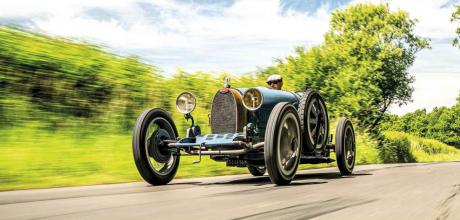1925 Bugatti Type 35A - driving a stunningly original prototype
In 1925, Bugatti offered a more customer-friendly version of its Type 35 Grand Prix car, which it named the 35A. Mark Dixon drives the prototype.
Photography Barry Hayden
BUGATTI TYPE 35A Driving a stunningly original prototype
FIRST of the FEW
Modem traffic can be a bit too slow for them, muses Stephen Gentry. We’re standing beside a patinated blue Bugatti Type 35A, parked at the side of a country road on a scorching hot day. I’ve just had my first drive of the car and my head is still reeling with just how together, how joyful, how utterly fabulous this particular Bugatti is.
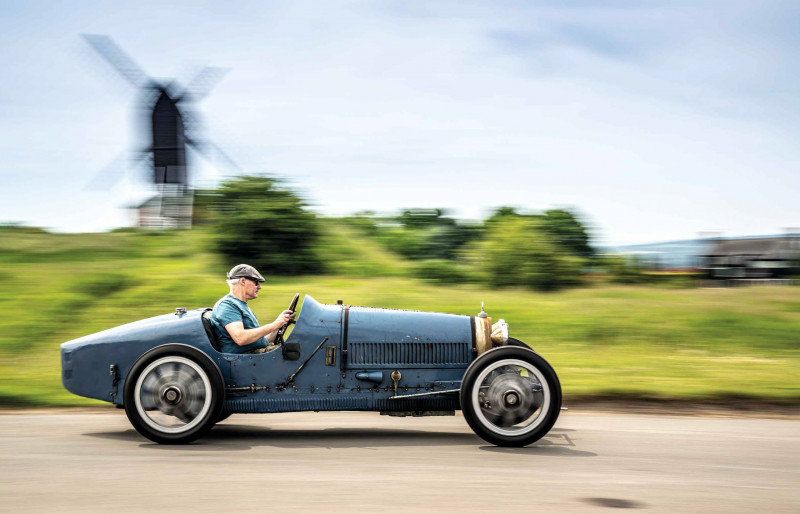
There’s a very good reason for that: it’s one of the most original examples left in the world, and it’s just emerged from a painstaking recommissioning by Stephen’s company, Buckinghamshire-based Gentry Restorations. This car, chassis 4541, is special in another way, too. It’s one of the first batch of nine 35As made, and very possibly the first of a total run of 139: it still has engine no.l, front axle no.l, rear axle no.2 and gearbox no. 12. That’s about as matching numbers as you can get with a vintage Bugatti.
‘Vintage gearchanges are what sort out the metaphorical men from the hypothetical boys’
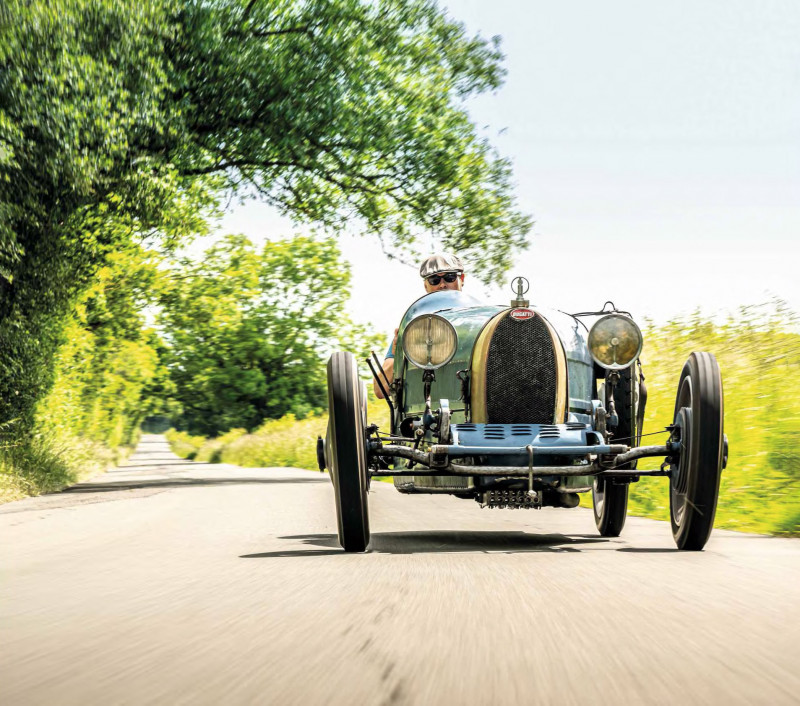
What it doesn’t have is the Type 35 Grand Prix car’s high-maintenance engine. Instead of a five-main-bearing crank with roller bearings — which could skid’ and wear prematurely — it has three mains, and uses simpler ball races. The 35A is, effectively, a detuned version of the racer, a more affordable alternative for road as well as circuit use.
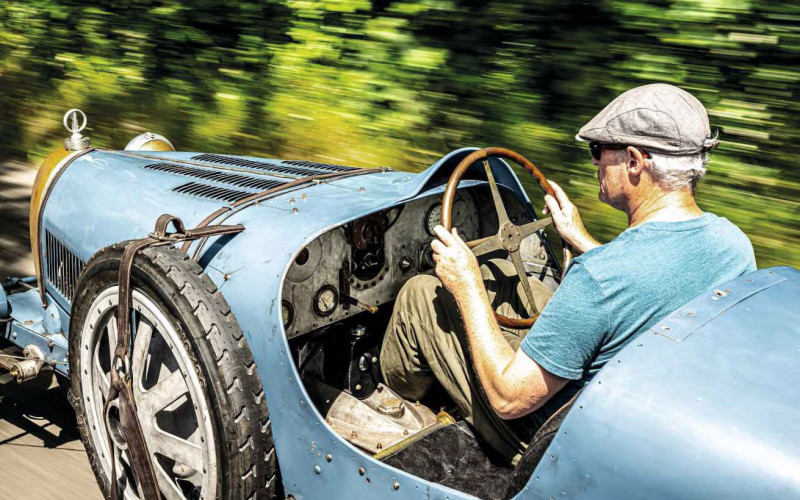
That doesn’t mean it’s at all slow, even though the engine puts out maybe 70bhp and its practical rev limit is 4000rpm rather than the 5500 or even 6000 of a Type 35. ‘You don’t need to rev it high,’ explains Stephen. ‘It has loads of torque and drivability.’ I’ve already found that out for myself, while pootling about at relatively low speeds for our photographer (first rule of car mags: always get the pics in the bag first). But, now that snapper Barry Hayden has pronounced himself happy, there’s time to take advantage of these deserted country roads on an afternoon in high summer.
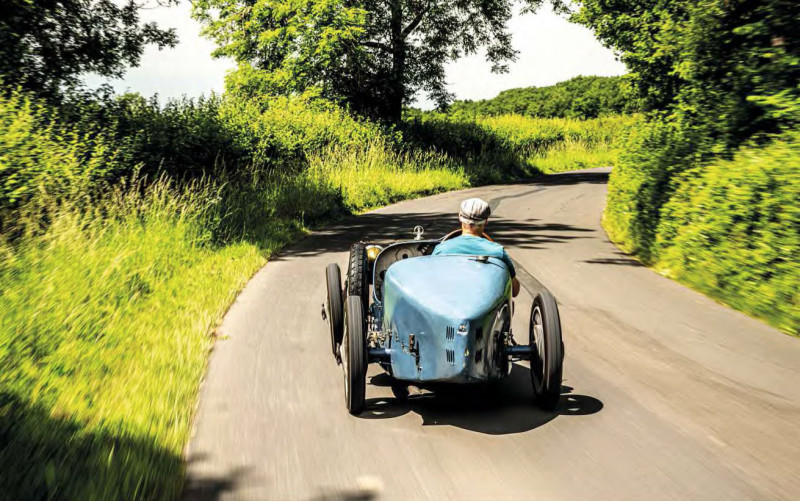
Of course, you need to exercise care when getting behind the wheel of a hugely valuable historic car. Easiest way is to enter from the passenger side and put your feet on the chassis tube — not the gear selector that runs from side-to- side in front of the seats — and shuffle across and under the wheel. Thankfully, the pedal layout is conventional and there’s no centre throttle: one less thing to think about.
Just as with a classic aircraft, there are a number of operations to perform before take-off. Sorting out the fuel supply is paramount: first you unscrew a miniature tap to your right, three turns, to let the fuel flow; then (if the engine is cold) you twist the uppermost of two turn-valves under the dash on your left. That one allows you to pressurise the fuel tank with the T-handled pump on the far left. However, once the engine is running, if you open the lower of those two valves, the engine-driven pump takes over. And, if it’s a really hot day like today, the sun itself can warm the tank enough for it to self-pressurise.
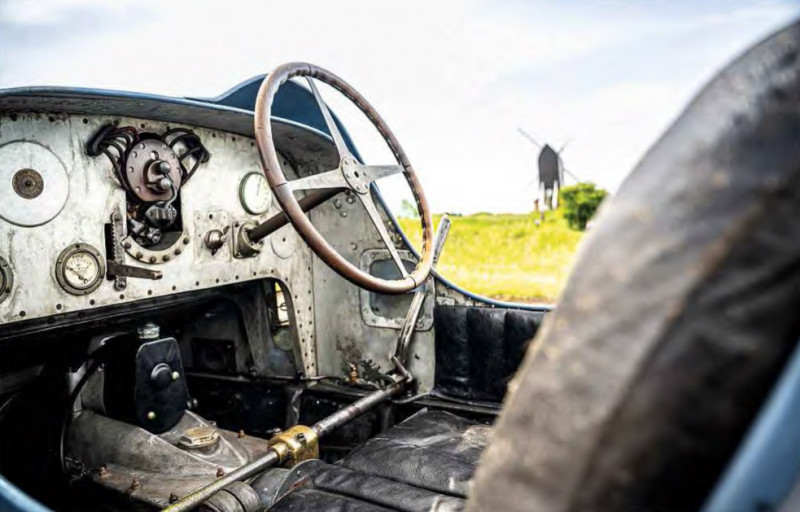
Just about the only deviation from originality on this car is a high-torque electric starter — it had to be started by hand, back in the day — but there’s a very good reason for that: the new owner, a Danish enthusiast, is keen to use the Bugatti on long-distance rallies, where having to hop out continually to crank the engine over would be a real pain. So, slip the car out of gear — the outside handbrake has no ratchet, so you leave the car in gear when parked up — turn the thumbs witch for the ignition, and press the button on top of the exposed starter. It needs only the briefest push before the straight-eight engine erupts instantaneously into life with a thrilling snarl. It sounds magnificent, gulping oxygen through its pair of chunky, unfiltered Solex carbs, and you haven’t even done more than blip the throttle yet.
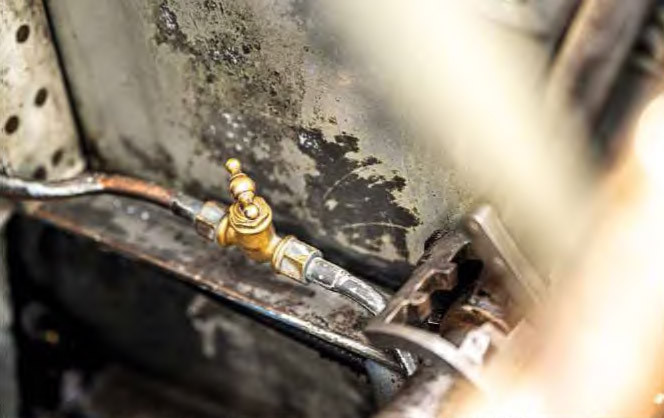
Next task: remember where the gears are. The gearlever, which projects outside the car through a slotted-leather hole, has a very close gate, with first and second in the plane nearest you, third and fourth a fraction further over. Just to keep things interesting, first is down, second is up, then third across and down, and fourth up. Push the button on top of the lever to actuate a metal lock-out lever for reverse.
Narrow, beaded-edge tyres running at the high pressures needed to keep them seated on their rims translate to light, direct steering, so pulling out of a parking spot requires little to no effort. The clutch is surprisingly progressive and not at all sharp, but it doesn’t have a lot of travel and so you have to balance the revs carefully as you move off, particularly when making a hill start. This is when you may be extremely grateful for that aftermarket starter motor: driving a Bugatti is cool, but stalling a Bugatti and then having to get out and get under’ when there’s traffic behind you is definitely not.
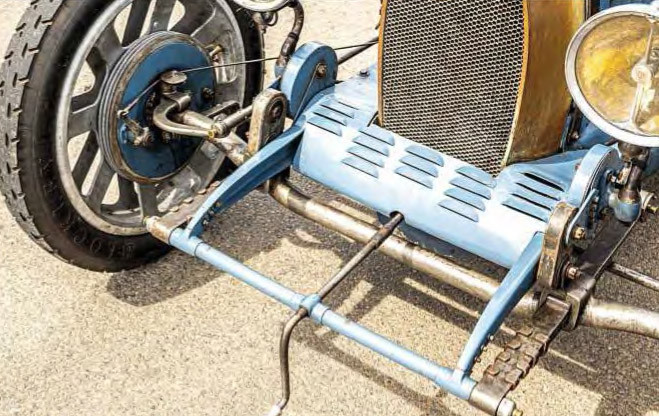
Vintage gearchanges are what sort out the metaphorical men from the hypothetical boys, but the Bugatti scores a bullseye here, too, since its ’change is not difficult, but not so easy that it doesn’t require any skill to operate quietly. Once the gearbox oil is warm, you don’t have to double-declutch at all when going up through the box: it’s best to shift up fairly early from first to second, be reasonably brisk when going from second to third, and then third to fourth is an easy straight push forward. Down-changes do require a double-declutch but the engine is so free-revving that you don’t have to pause long — the hardest bit is acclimatising to that very close gate. It’s an intensely mechanical experience, and a very satisfying one.
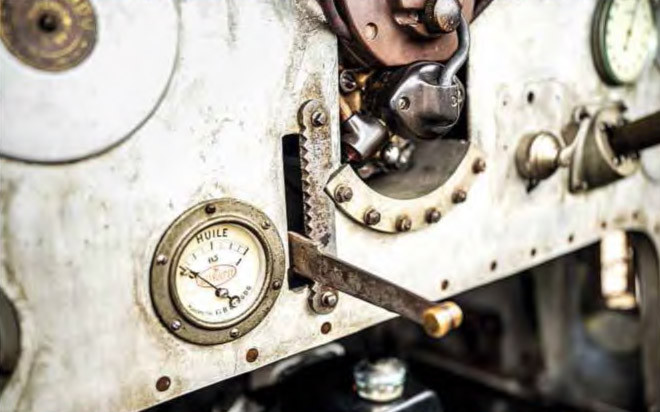
The engine is what a Bugatti is all about, though, and this one feels as lively as the day it left the Molsheim test-bed in May or June 1925. It may not have the fancy roller-bearing crank and con-rods of the Grand Prix engine, and it may only produce an estimated 70bhp, but it rasps and crackles just the same and there’s still that classically cliched ‘tearing calico’ sound effect when the revs crest 3000rpm. It moves this featherweight roadster along very swiftly, too; it would have felt like a rocketship in its day and it’s still impressive nearly a century later.
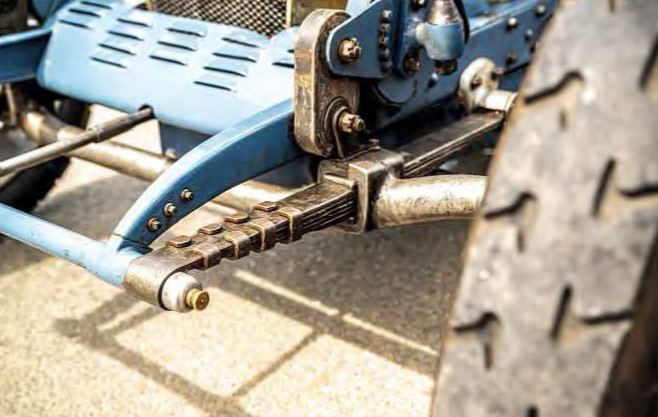
Speed is only one element in play here; driving the Bugatti hard and fast involves so much more than the rush of air, the blare of the exhaust and the blur of the scenery, thrilling though that is. If you’re pressing on, you can’t afford to relax your guard for an instant: the ride is distinctly lively, never harsh but always busy, and it’s best to allow the car to find its own course, keeping the lightest of touches on that thin- rimmed wheel, while being ready to correct sudden deflections caused by bumps and holes in the road. This is a car that demands your attention, and rising to the challenge will give you such a high. Most importantly, it makes you feel at one with your surroundings, in tune with the elements and with the birdsong and the sudden changes in temperature you can feel from field to field as you whizz by. Today’s hypercars are incredible machines but they are almost literally other-worldly. A fast vintage car is as of-this-world as you can get.
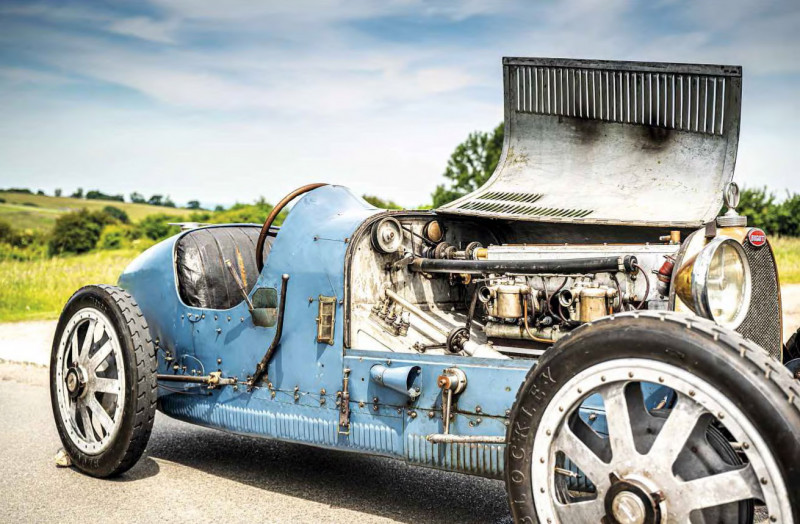
This Type 35A would be a delight to own simply for its merits as a driver’s car, but there’s so much more to this particular example. Specialist Bugatti consultants David Sewell and Mark Morris produced an in-depth report for its new owner, and it turns out that chassis 4541 has superb provenance. Its first owner was none other than a princess, Marie de Ligne, who was your perfect stereotypical French aristo, owning a villa in Cannes as well as residences in Paris, Belgium and Algeria. One of her cousins also happened to co-own the Bugatti agency in Paris.
Marie de Ligne took delivery of the 35A in June 1925 and kept it until October 1927; it then had a second owner in Normandy, before passing to a well-known garage owner in the Dordogne called Georges Dubos in 1933. Astonishingly, his chalked signature and the date 17 Fevrier 1933 were recently uncovered on the side of the petrol tank.
A photo from this time shows the car wearing competition numbers — and, more excitingly, the magnesium alloy wheels more usually associated with Grand Prix cars. There’s a theory that 4541 was a ‘transitional’ prototype 35A, since nearly all 35As were fitted with less-expensive wire wheels. Likewise, 4541 retains the magneto ignition that was very soon ditched for a cheaper coil-and-distributor set-up.
From 1941 to 1959, the Bugatti was owned by another Dordogne resident, a monsieur Camille Bondu, when it was discovered by a well-known Bugatti hunter, Jacques du Montant, who specialised (like his late brother Jean Louis) in finding cars to sell to wealthy Americans. He sold 4541 to one of his regular clients, an Ohio jeweller and car collector called Joe Loecy, and it was shipped to the USA. By then, 4541 was wearing wire wheels like most of its brethren.
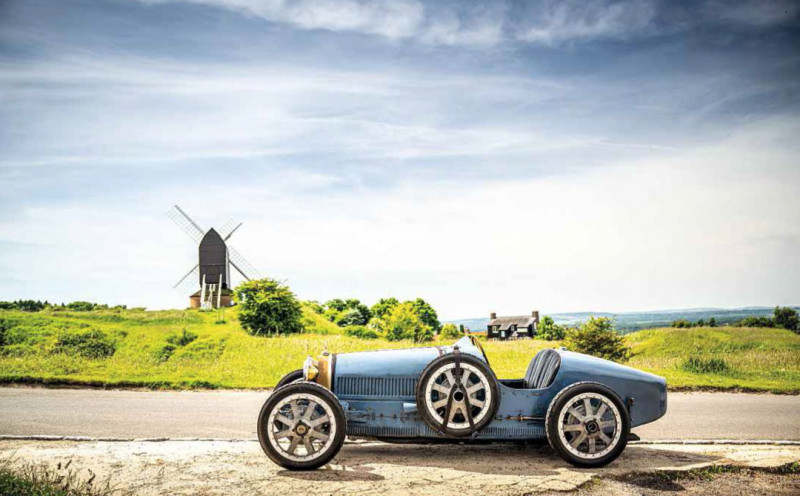
And, thankfully, this is when the car was in effect mothballed. Some time around 1979 it passed to the Indianapolis Motor Speedway Museum, where it remained until 2012. From 1959 until then, the car had been largely untouched, other than at some point receiving a blow-over in its current French blue. Incredibly, when the car was examined recently, the original seat cushion and seat back were found beneath later coverings. Intact but fragile, they have remained with the car (and appear in our photos) but are replaced with new replicas for driving sessions.
Gentry Restorations’ super-sensitive recommissioning included adding patinated modern copies of the magnesium alloy wheels shown in the 1930s photo, and cleaning off the non-original blue paint where it had been liberally sprayed over suspension and steering parts that should be left as polished bare metal. What is truly astounding is that the radiator core, after a thorough cleaning, did not need to be replaced. There’s no anachronistic electrical fan and the engine showed not a trace of overheating during our stop-start driving on one of the hottest days of 2022.
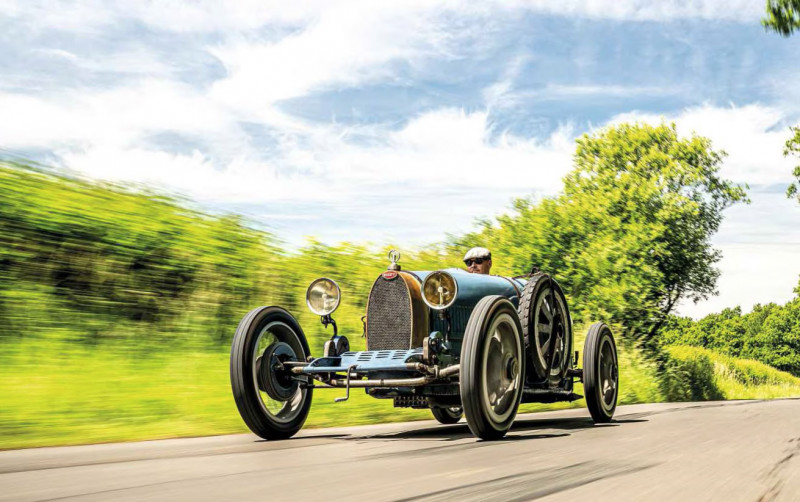
The straight-eight is also a remarkable survivor. The engine crankcase is a regular Type 35 block with the unused roller bearing oil feeds blanked off; later 35A engines didn’t have the unnecessary machining in the first place. Gentry’s engineer Ian Paveley and apprentice Ellie Gentry (yes, it really is a family business; Ellie is Stephen’s daughter) racked-up more than a year on overhauling the drivetrain, and, from the effortless way in which the car performs, it was time well spent. Yet another jaw-dropping fact: this engine is still running on its original crankshaft and camshaft.
Chassis 4541 is a truly special car, all right. As Morris and Sewell summed up in their report: ‘There is no other recorded Type 35A or Type 35 which is comparable, both in continuous history and originality… It sets an exceptional benchmark for reference as to what a true Type 35A would have been like when delivered from Molsheim.’
It genuinely does not get any better than that.
Below and bottom left Engine is in essence a detuned version of the Type 35 Grand Prix racer's, with a simpler crankshaft for ease of maintenance; this very early car features magneto ignition, projecting through the dashboard.
This page This Bugatti is stunningly original, a true survivor car: apart from replacement wheels and a decades-old paint job, it is pretty much as built in 1925.
TECHNICAL DATA 1925 Bugatti Type 35A
- Engine 1991cc straight-eight, cast-iron block and head, alloy crankcase, three-bearing crankshaft, three valves per cylinder, two Solex carburettors
- Max Power c70bhp
- Transmission Four-speed manual gearbox, rear-wheel drive
- Steering Worm and wheel
- Suspension Front: hollow axle, semi-elliptic leaf springs, friction dampers. Rear: live axle, reversed quarter-elliptic leaf springs, radius rods, friction dampers
- Brakes Cable-operated drums
- Weight 650kg
- Top speed c95mph


